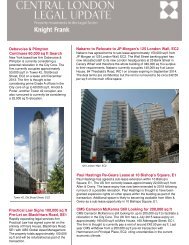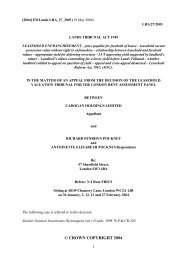40 Chelsea Square - Knight Frank
40 Chelsea Square - Knight Frank
40 Chelsea Square - Knight Frank
Create successful ePaper yourself
Turn your PDF publications into a flip-book with our unique Google optimized e-Paper software.
his view that the like approach to the assessment of fair rents was “wrong” and “failed to<br />
achieve what was intended by the legislation.”<br />
115. LVT decisions on questions of fact or opinion are indirect or secondary evidence and<br />
should be given little or no weight in other LVT proceedings and in proceedings in this<br />
Tribunal, even if they are admissible. In Land Securities Plc v Westminster City Council<br />
(1992) 44 EG 153, the issue was whether an arbitrator’s award determining the market rent of<br />
an office building on review was admissible evidence in another rent review relating to<br />
adjoining offices. Hoffman J, after referring to the admissibility of evidence of rents in the<br />
market and on review, said (at 155):-<br />
“An arbitration award on the other hand is an arbitrator’s opinion, after hearing the<br />
evidence before him of the rent at which the premises could reasonably have been let.<br />
The letting is hypothetical, not real. It is therefore not direct evidence of what was<br />
happening in the market. It is the arbitrator’s opinion of what would have happened.<br />
In principle the judgement, verdict or award of another tribunal is not admissible<br />
evidence to prove a fact in issue or a fact relevant to the issue in other proceedings<br />
between different parties. The leading authority for that proposition is Hollington v<br />
Hewthorn and Co Ltd …”<br />
He concluded that the award was inadmissible and said (at 158):-<br />
“This is not in my view a technical decision on outdated rules of evidence. Properly<br />
analysed I think that the arbitrator’s award has in itself insufficient weight to justify the<br />
exploration of otherwise irrelevant issues which its admissibility would require.”<br />
116. The same principles apply to decisions on matters of fact or opinion by LVTs and this<br />
Tribunal (see eg Cadogan Estates Limited v Hows where earlier decisions of LVTs and this<br />
Tribunal on yield were rejected in favour of settlement evidence), although a decision of this<br />
Tribunal may be referred to where general guidance has been given on valuation principles or<br />
procedure (eg Clinker & Ash Limited v Southern Gas Board (1967) 203 EG 735: observations<br />
on the use of the residual method of valuation in litigation).<br />
117. It is this basis that we distinguish between relying upon a conventional figure, which we<br />
wholly reject, and adopting a conventional method of valuation, which may be justified either<br />
by the availability of evidence with which to support different stages of the valuation or<br />
because of the advantage of transparency in understanding the basis of the valuation. The<br />
difficulty of identifying comparable evidence to support the choice of deferment rate to be<br />
applied to the current open market value may justify further thought being given to the<br />
convention of valuing the rental income separately from the reversion, but that is the basis<br />
upon which all the valuers in these appeals have proceeded and we accept that it is probably a<br />
convenient convention to adopt, and certainly not one from which we should depart in these<br />
appeals.<br />
26









